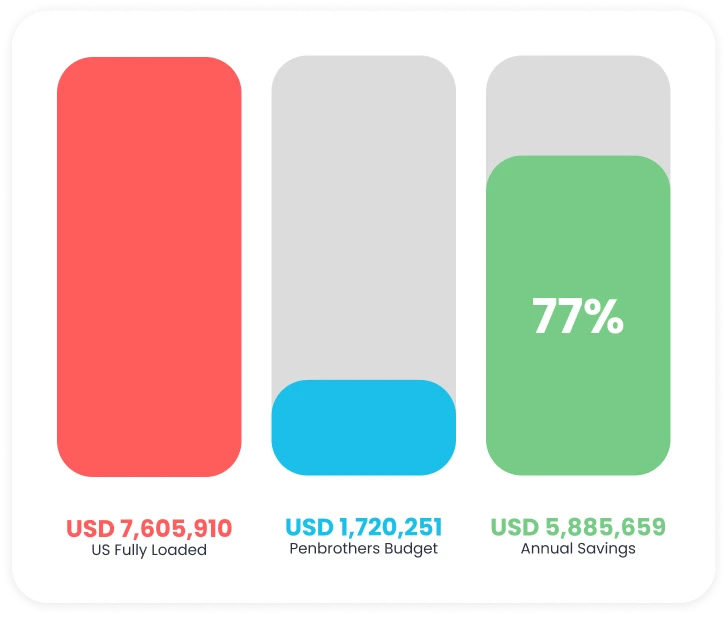Key Takeaways
- Hybrid outsourcing combines local and offshore strengths, balancing cost efficiency with cultural alignment and quality.
- Traditional outsourcing often falters due to miscommunication, integration issues, and limited oversight.
- The hybrid model enhances collaboration, scalability, and access to global talent while staying cost-effective.
- Case studies like Luxclusif show how strategic outsourcing can reduce costs by 77% while fueling growth.
- Companies adopting hybrid outsourcing are positioning themselves for long-term agility, innovation, and resilience.
As the business world accelerates into uncharted territory, companies are boldly embracing hybrid outsourcing models that seamlessly blend the strengths of both onshore and offshore teams. This innovative strategy not only boosts operational efficiency but also unlocks access to a rich tapestry of global talent, allowing organizations to harness unique skills and perspectives from around the world.
Recent insights reveal a powerful trend: a remarkable 70% of organizations identified by Gartner are viewing hybrid outsourcing as a strategic pathway to sharpen their competitive edge. This isn’t just a trend; it’s a transformative shift redefining how companies operate and thrive on the global stage. By adopting hybrid models, businesses are not merely cutting costs; they are enhancing project outcomes and positioning themselves for sustainable success in an increasingly competitive landscape.
Defining Traditional Outsourcing and Hybrid Outsourcing
Traditional Outsourcing
Traditional outsourcing refers to contracting external service providers to handle specific business functions or processes, often involving offshoring to reduce costs. Commonly outsourced functions include customer service, IT support, manufacturing, and back-office operations. The primary focus of traditional outsourcing has historically been cost reduction, with companies seeking to save money by leveraging lower labor costs in other regions. According to Deloitte’s Global Outsourcing Survey, approximately 70% of companies cited cost savings as the main reason for outsourcing.
Hybrid Outsourcing
In contrast, hybrid outsourcing blends both onshore and offshore resources. This model combines the benefits of local teams, who possess a deep understanding of the company’s culture and operational standards, with the advantages of offshore teams, who provide cost-effective solutions and specialized skills. Hybrid outsourcing emphasizes collaboration, allowing in-house teams to work closely with outsourced personnel, thereby enhancing communication and project management.
Key Differences
- Location of Teams: Traditional outsourcing often relies solely on offshore teams, while hybrid outsourcing incorporates both onshore and offshore resources.
- Focus: Traditional outsourcing typically prioritizes cost savings, whereas hybrid outsourcing balances cost efficiency, quality, and collaboration.
- Control and Oversight: Traditional outsourcing can lead to a disconnect between in-house teams and external providers, resulting in less control over processes. Hybrid outsourcing promotes closer integration, allowing for better oversight and communication.
- Flexibility: Hybrid outsourcing provides more flexibility in team composition and resource allocation, enabling companies to adapt quickly to changing project demands.
What Are the Three Types of Outsourcing?
When companies consider outsourcing, they typically choose from three main models:
- Onshore Outsourcing – Contracting service providers within the same country. It allows easy communication and cultural alignment but often comes at a higher cost.
- Nearshore Outsourcing – Partnering with providers in neighboring countries. This balances cost savings with overlapping time zones and cultural similarities.
- Offshore Outsourcing – Working with providers in distant regions, usually to tap into significant cost efficiencies and specialized global talent.
The hybrid outsourcing model builds on these foundations by combining elements of onshore, nearshore, and offshore outsourcing, offering businesses both cost optimization and strong collaboration.
Understanding the Challenges of Traditional Outsourcing
Business leaders today face numerous challenges, from talent shortages to cultural integration issues. For instance, a significant percentage of mid-sized companies report difficulties in attracting top talent. According to Gallup, 52% of employees globally are actively watching for or seeking new job opportunities, highlighting the tight labor market. Traditional hiring methods are often insufficient, leading to delays and unmet project timelines. Additionally, integrating remote teams with existing onshore operations can introduce communication barriers and cultural misunderstandings.
Organizations that do not adapt to the hybrid model may struggle with high operational costs and limited access to specialized skills. This is particularly evident in sectors like software development, where the demand for expertise far outpaces supply. The Everest Group’s 2022 Global CFO Survey notes that 66% of organizations are incorporating a hybrid operating model to improve agility and resilience.
The Benefits of Hybrid Outsourcing
- Cost-Effectiveness
Hybrid outsourcing presents a unique opportunity for cost optimization. By leveraging offshore resources where labor is more affordable, companies can reduce their overall operational costs while maintaining a high standard of quality. For example, combining lower-cost offshore talent with skilled onshore teams allows businesses to maintain oversight and control without compromising quality. Firms adopting a hybrid model can often achieve better financial performance than those relying solely on domestic resources. The BPO market is expected to grow at a CAGR of 8.5% from 2024 to 2029, indicating a shift towards more flexible operational strategies.
- Enhanced Collaboration
The hybrid model enhances collaboration by fostering closer working relationships between in-house and outsourced teams. Regular interactions, facilitated by modern communication tools, ensure that all team members are aligned with project goals. Improved collaboration leads to more effective problem-solving and innovation. Organizations employing hybrid models report stronger communication and teamwork, which are essential for the success of complex projects. A recent PwC survey found that 57% of business leaders noted their organizations performed better against workforce performance and productivity targets during the shift to hybrid and remote working, highlighting the positive impact of collaboration in hybrid teams.
- Scalability and Flexibility
One of the most compelling aspects of hybrid outsourcing is its inherent scalability. Companies can adjust the size and composition of their teams based on project requirements, enabling them to respond swiftly to market changes. This flexibility is crucial in today’s fast-paced environment, where project demands can shift rapidly. Much of this flexibility is powered by asynchronous work practices that hybrid teams rely on. Organizations can scale up or down without the long-term commitments associated with traditional hiring practices, allowing for a more dynamic approach to resource management. In practice, this often means choosing between async and sync communication styles depending on the task and urgency.
- Access to a Global Talent Pool
Utilizing a hybrid outsourcing model opens the door to a vast array of global talent. Companies can access specialized skills that may not be available locally. This approach not only enhances project quality but also fosters diversity, leading to more innovative solutions. The integration of multicultural teams can significantly improve creativity and problem-solving capabilities, ultimately resulting in superior project outcomes. According to a report from McKinsey, companies with diverse teams are 35% more likely to outperform their competitors.
What Is the Hybrid Shared Services Model?
The hybrid shared services model merges internal shared services with outsourced support. In this setup, certain core business functions such as HR, finance, or IT are centralized in-house to maintain control, while other processes are outsourced to external partners for efficiency.
This model provides the best of both worlds: organizations keep strategic oversight of sensitive operations while gaining the scalability and cost benefits of outsourcing. For global companies, it means flexibility in deciding which processes remain close to home and which can be delivered more efficiently across borders.
Penbrother’s Success Story: How Luxclusif Achieved 78% Cost Savings Through Strategic Outsourcing
Luxclusif, a luxury resale platform based in Portugal, faced significant challenges in scaling its logistics, finance, and technical teams while maintaining cost control—an essential hurdle for any bootstrapping startup in the competitive luxury retail market. By partnering with Penbrothers, Luxclusif gained access to skilled and affordable talent in the Philippines, allowing them to streamline operations. Penbrothers managed HR functions, including recruitment, payroll, and compliance, enabling Luxclusif’s leadership to concentrate on core business growth.
This strategic partnership resulted in an impressive 77% reduction in Luxclusif’s average cost per role, significantly enhancing the company’s financial stability and increasing its attractiveness to potential investors. The operational efficiency achieved through this collaboration not only improved profitability but also provided the necessary resources for Luxclusif to innovate and expand its service offerings.
Payroll Savings For 2023

In 2021, the success of this operational model culminated in Luxclusif’s acquisition by Farfetch, solidifying its position in the global luxury resale market. This case exemplifies how a well-structured outsourcing partnership can empower startups to navigate financial constraints and achieve substantial growth, even in high-cost, competitive industries.
The Path to Hybrid Outsourcing Success
As you contemplate the potential of hybrid outsourcing for your organization, it is vital to take strategic steps forward. Begin by assessing your current team structure and identifying areas where external support could enhance your capabilities. Explore partnerships with established outsourcing firms that share your business values and are adept at managing cross-border teams.
The hybrid outsourcing model is not just an option; it is becoming the norm for organizations seeking to enhance their operational effectiveness. By embracing this approach, you can improve your global reach and ensure your business remains competitive in an increasingly interconnected world. Still, some leaders hesitate because of common myths about offshore and hybrid teams.
Are you ready to explore the advantages of hybrid outsourcing?
Start the conversation today and discover how this model can transform your operations.
Frequently Asked Questions (FAQs)
Hybrid outsourcing combines both onshore and offshore resources, striking a balance between cost savings and local oversight, cultural fit, and higher-quality collaboration.
Many move to hybrid models to solve challenges like miscommunication, lack of oversight, and talent shortages that traditional outsourcing can’t fully address.
By combining in-house oversight with offshore talent, hybrid setups foster better communication, aligned workflows, and stronger teamwork across borders.
Yes. Companies can quickly adjust team size and expertise based on project demands without the long-term costs of local hiring.
Tech, software development, customer support, and finance-heavy sectors often benefit, as they require specialized talent at scale and speed.






